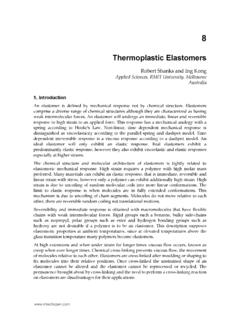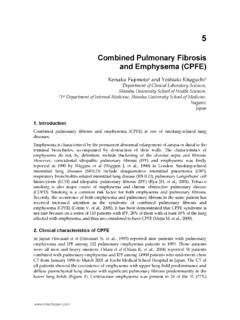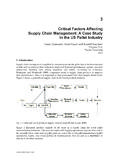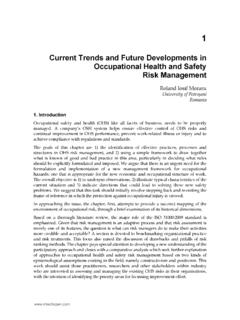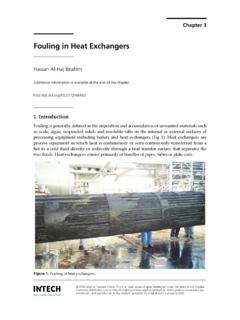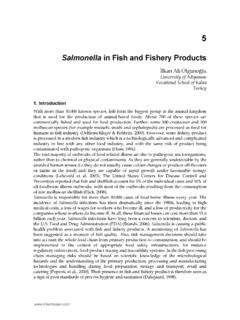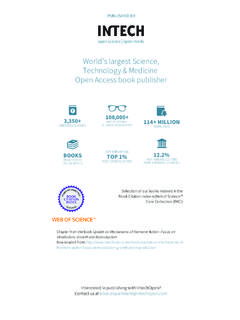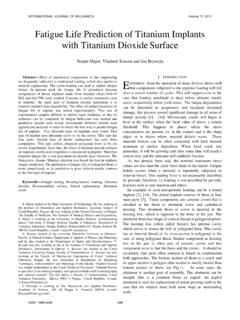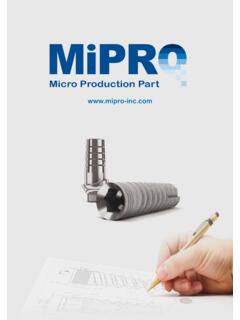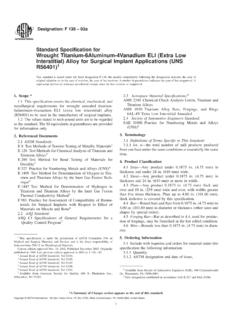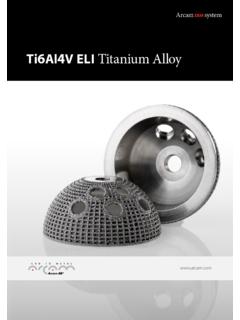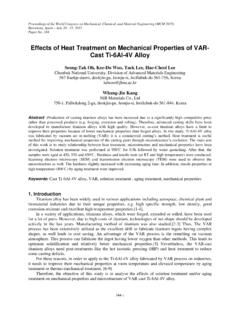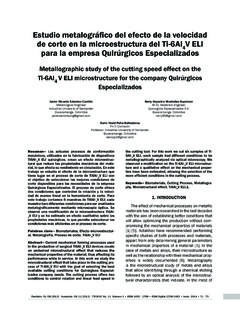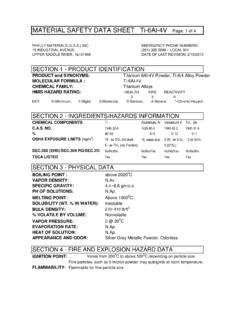Transcription of Fatigue of Ti-6Al-4V - InTech - Open
1 Chapter 3 2012 Hosseini, licensee InTech . This is an open access chapter distributed under the terms of the Creative Commons Attribution License ( ), which permits unrestricted use, distribution, and reproduction in any medium, provided the original work is properly cited. Fatigue of Ti-6Al-4V Shabnam Hosseini Additional information is available at the end of the chapter 1. Introduction Metallic biomaterials have essentially three fields of use; these are the artificial hip joints, screw, plates and nails for internal fixation of fractures, and dental implants. Any of these devices must support high mechanical load and resistance of material against breakage is essential. High mechanical properties are needed for structural efficiency of surgical and dental implants. But their volume is restricted by anatomic realities what require good yield and Fatigue strengths of metal [1].
2 The use of titanium alloys is due to their excellent corrosion resistance. Also, that is because of their tensile strength, a high strength to weight ratio and low elastic modulus. titanium continues to be widely used in biomedical applications. Ti-6Al-4V alloy is the most frequently used these days [2]. Fatigue fracture and wear have been identified as some of the major problems associated with implant loosening, stress-shielding and ultimate implant failure. Although wear is commonly reported in orthopedic applications such as knee and hip joint prostheses, it is also a serious and often fatal experience in mechanical heart valves. illustrates some examples of Fatigue fracture of implant devices in the hip prosthesis and a mechanical heart valve. It can be seen that Fatigue -wear interaction plays a significant role in ultimate failure of these medical devices [3].
3 In orthopedic implants design, it is unavoidable the presence of geometrical fillets such as notches which cause stress locally. It's necessary to pay attention these notches, because they affect on Fatigue resistance [4]. In addition about Fatigue ratio, Fatigue notch factor, notch sensitivity and effect of ultimate strength and notch size on the Fatigue strength of Ti-6Al-4V will be discussed. Orthopedic metal alloys The main goal of design and fabrication of an orthopedic biomaterial is to restore the function and mobility of the native tissue that is considered to be replaced. In order to select an ideal Biomedical Engineering Technical Applications in Medicine 76 biomaterial for orthopedic and dental applications specific property requirements must be fulfilled. The ideal materials for hard tissue replacement should be biocompatible and bioadhesive, possess adequate mechanical properties to tolerate the applied physiological load, be corrosion/wear resistant and finally show good bioactivity to ensure sufficient bonding at the material/bone interface.
4 The materials used in orthopedic surgery can be divided into five major classes of metals, polymers, ceramics, composites, and natural materials [5]. Figure 1. Some examples of Fatigue failure of medical devices: (a) hip prosthesis; (b) explanted Bjo rk Shiley polyacetal disc mechanical heart valve(arrow indicates Fatigue -wear mark)[1]. Compared to other biomaterials like ceramics and polymers, the metallic biomaterials offer a wider range of mechanical properties such as high strength, ductility, fracture toughness, hardness, formability, as well as corrosion resistance, and biocompatibility. These are the required properties for most load-bearing applications in fracture fixation and bone replacement (total joint arthroplasty) [5]. Standard metallic orthopedic materials include stainless steels, cobalt-base alloys , and titanium base alloys (table 1), with an increasing number of devices being made of titanium and titanium alloys .
5 The latter alloys are generally preferred to stainless steel and Co- alloys because of their lower modulus, superior biocompatibility and corrosion resistance [6]. titanium and its alloy as orthopedic biomaterials The need to find more reliable materials to replace broken or deteriorating parts of the human body is increasing with the increase in number of both younger and older recipients. Modern surgery and dentistry need metals and alloys of extreme chemical inertness and adequate mechanical strength. Metals and alloys in use include stainless steel, Co-Ni-Cr alloy, cast and wrought Co-Cr-Mo alloy, commercially pure titanium , Ti-6Al-4V alloy and other titanium alloys [7]. Recently, new titanium alloy compositions, specifically tailored for biomedical applications, have been developed. These first generation orthopedic alloys included Ti-6Al-7Nb and Two alloys with properties similar to Ti-6Al-4V that Fatigue of Ti-6Al-4V 77 were developed in response to concerns relating V to potential cytotoxicity and adverse reaction with body tissues.
6 Further, biocompatibility enhancement and lower modulus has been achieved through the introduction of second generation titanium orthopedic alloys including Ti-12Mo-6Zr-2Fe (TMFZ), Ti-15MO-5Zr-3Al, Ti-15Mo-3Nb-3O, and alloys , as well as the completely biocompatible Ti-13Nb-13Zr alloy [6]. Commercially pure titanium is a material of choice as an implant because of its biocompatibility resulting in no allergic reaction with the surrounding tissue and also no thrombotic reaction with the blood of human body. The average yield strength of commercially pure titanium is approximately 480 MPa. If a higher strength of the implant is necessary, for example, in hip prosthesis, titanium alloys have to be used. The most widely used alloy, Ti-6Al-4V , reaches yield strength almost double the yield strength of commercially pure titanium [7].
7 Stainless steels Cobalt-base alloys Ti & Ti-base alloys Designation ASTM F-138 (316 LDVM) ASTM F-75 ASTM F-799 ASTM F-1537 (Cast and wrought) ASTM F-67(ISO 5832/II) ASTM F-136(ISO 5832/II) ASTM F-1295 (Cast and wrought) Principal alloying Elements (wt%) Fe(bal.) Cr(17-20) Ni(12-14) Mo(2-4) Co(bal.) Cr(19-30) Mo(0-10) Ni(0-37) Ti(bal.) Al(6) V(4) Nb(7) Advantages Cost, availability processing Wear resistance Corrosion resistance Fatigue strength Biocompatibility Corrosion Minimum modulus Fatigue strength Disadvantages Long term behaviorHigh modulus High modulus Biocompatibility Power wear resistance Low shear strength Primary utilizations Temporary devices(fracture plates, screws, hip nails) Used for THRs stems In UK (high Nitrogen) Dentistry castings Prostheses stems Load-bearing components In TJR(wrought alloys ) Used in THRs with modular (CoCrMo or ceramic) femoral heads long-term, permanent devices (nails, pacemakers) Table 1.
8 Some characteristics of orthopedic metallic implant materials [6] Biomedical Engineering Technical Applications in Medicine 78 titanium is a transition metal with an incomplete shell in its electronic structure enables it to form solid solution with most substitutional elements having a size factor within 20%. In its elemental form titanium has a high melting point (1678 C), exhibiting a hexagonal close packed crystal structure (hcp) up to the beta ( C), transforming to a body centered cubic structure(bcc) above this temperature. titanium alloys may be classified as either , near- , + , metastable or stable depending upon their room temperature microstructure. IN this regard alloying elements for titanium fall into three categories: -stabilizers, such as Al, O, N, C, -stabilizer such as Mo, V, Nb, Ta, Fe, W, Cr, Si, Ni, Co, Mn, H and neutral, such as Zr.
9 And near- titanium alloys exhibit superior corrosion resistance with their utility as biomedical materials being principally limited by their low ambient temperature strength. In contrast, + alloys exhibit higher strength due to the presence of both and phases. Their properties depend upon composition, the relative proportions of the / phases, and the alloy s prior thermal treatment and thermo-mechanical processing conditions. alloys (metastable or stable) are titanium alloys with high strength, good formability and high hardenability. alloys also offer the unique possibility of combined low elastic modulus and superior corrosion resistance[8]. Ti alloys were first used in orthopedics in the mid-1940s and have continued to gain attention because of their unique properties, including high specific strength, light weight, excellent corrosion resistance and biocompatibility.
10 Due to the aforementioned properties, this class of materials exhibits tremendous clinical advantages in terms of reduced recovery time and rehabilitation, and improved comfort for patients. However, for bone replacement components, the strength of pure Ti is not sufficient and Ti alloys are preferred due to their superior mechanical properties. In general, alloying elements would lead to an improvement in the properties of Ti for orthopedic applications. Ti-6Al-4V ELI and NiTi shape memory alloys (SMA) are the most commonly used Ti alloys in orthopedic applications because of their good combination of mechanical properties and corrosion resistance. However, the possible release of toxic ions from aluminum (Al), vanadium (V) and nickel (Ni) during in vivo corrosion of the implant remains the matter of concern.


